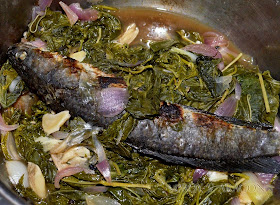 |
| Samsamping, parda ken kabatiti a nabaradibudan iti bagas ti kamangeg. |
I always see a yet another delicious starchy dinengdeng called buridibud when I see kamangeg, So this is yet another opportunity to make one, what with the perfect willd veggie fruit of a samsamping to pair it.
Luckily, I also got another so-called "native" Ilokano vegetable fruit: parda (Dolichos lablab Linn; hyacinth bean) which is just so good a pair for my buridibud.
So, there, this parda:
And the samsamping:
I also got the smaller and sweter native kabatiti (sponge gourd; not photographed) as another veggie fruit for that perfect buridibud. Together they will grace my platefuls of steamed rice. But first things first, I boiled some bugguong in a minimal amount of water, with some slices of onions for aroma and flavor. Afterwhich I simmered into the bubbling bugguong mixture the cut kamangeg, let it cook for about 20-30 minutes and then into it the kabatiti, samsamping and parda. Here it is, stewing and becoming thick and starchy:
And here's it, done! The broth is just as rich and thick and so flavorful and deliciously starchy and sweet. The fruit veggies are just cooked right not overcooked, to retain it's gorgeous color and crispness:
A really simple and easy dish but so good and healthy. Just plain dinengdeng/buridibud without sagpaws or add-ons to really savor the veggies and the rare kamangeg. Absolutely amazing Ilokano food!
:::::

























































